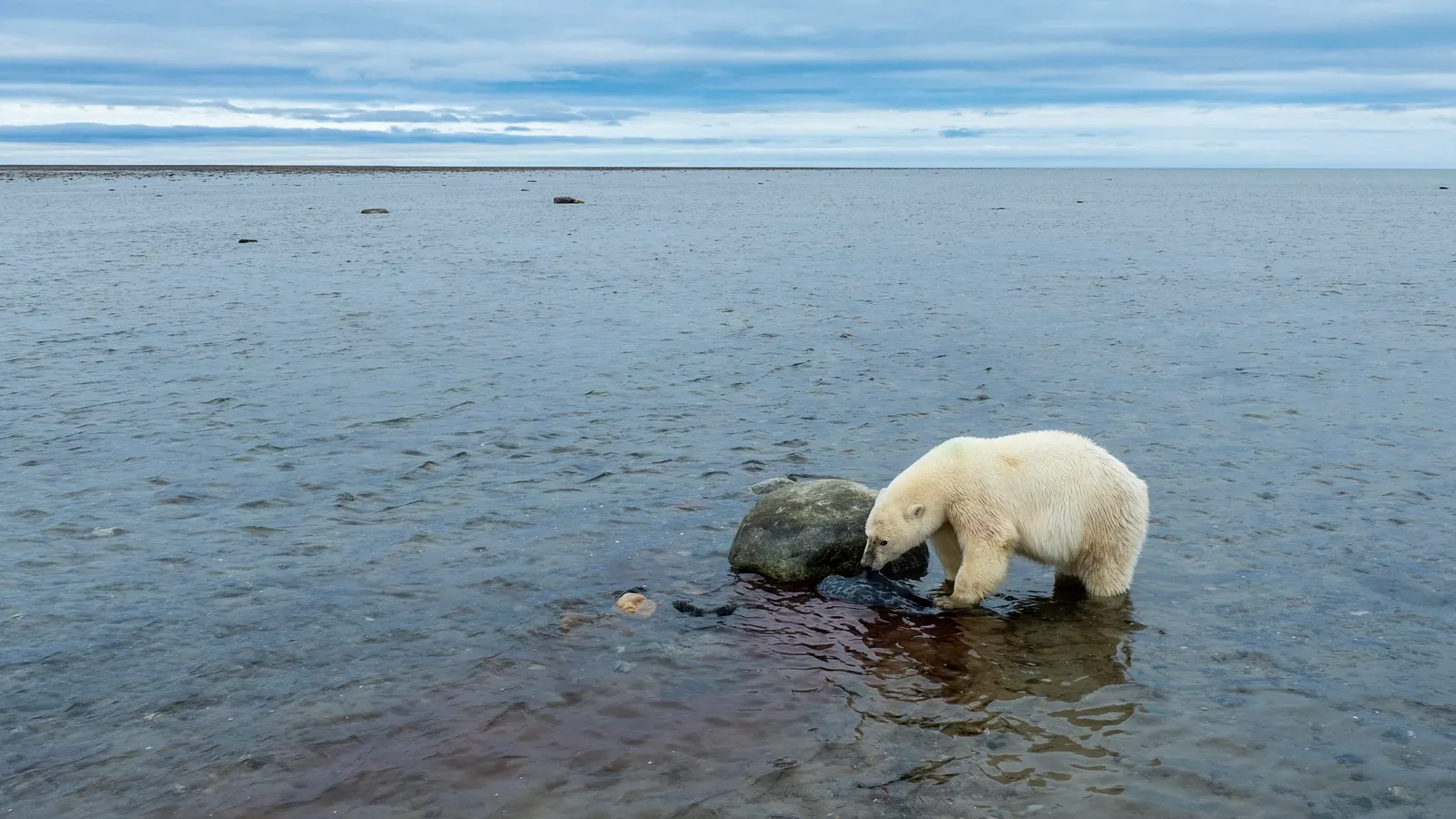Copyright forbes

A polar bear feasts on a seal it captured in the receding tide along the Hudson Bay Lowlands. John MacGillivray, Dorsey Pictures Ryan St. John peers through his binoculars on the shore of Hudson Bay near his home community of Arviat, Nunavut, an Inuit village of 3,000 residents in north central Canada. “There’s another polar bear that’s caught a seal,” he says. The bear is standing 800 yards away stripping and eating pieces of flesh amid a mile-wide flat exposed by low tide. Hudson Bay is a 475,000-square-mile body of saltwater dipping into central Canada. This is the second bear we’ve encountered in as many hours that is feeding on a ring seal, the roughly 70-pound sea mammal that is the polar bear’s preferred meal rich in highly caloric fat. Ryan St. John has spent 40 years hunting the shores of Hudson Bay and says there has never been more polar bears in the area. Dorsey Pictures It’s mid-October and the ice is late this year; though last year saw an unusually cold winter with early ice. Despite the lack of sea ice so far this season, the bears have little problem catching seals, says St. John. “They’re resilient predators,” he says. “I’ve watched them stalk seals many times on the flats. The seals sometimes get caught at low tide, too slow to get back into the retreating water. As Inuit who live with the bears, we are seeing them adapt very quickly. They are killing seals on the tidal flats, in the open water and we are also seeing bears hunt and kill beluga whales. We’ve seen eight bears so far today and they’re all fat and healthy.” For 52-year-old St. John, he’s been hunting in the region for some four decades and says there are more polar bears today than ever in his area, one of the richest polar bear zones in the world. Of the roughly 30,000 polar bears found worldwide, more than half reside in Canada with the Hudson Bay Lowlands hosting some of the highest concentrations. MORE FOR YOU Despite what he sees as an abundance of bears, St. John is all too familiar with images of polar bears becoming posters for environmental groups advancing a global climate change narrative. In 2017, when two National Geographic cinematographers, Paul Nicklen and Cristina Mittermeier, filmed an emaciated and starving polar bear on Somerset Island in northern Canada, more than 2.5 billion people worldwide saw those images—the most viewed clip ever posted by the Society. The footage ran under a banner proclaiming, “This is what climate change looks like.” The Inuit village of Arviat, Nunavut, is one of many communities across northern Canada negatively impacted by the U.S. polar bear trophy import ban. John MacGillivray, Dorsey Pictures Some scientists, however, accused National Geographic of playing, “loose with the facts.” In a report issued by the Foundation for Economic Education, author Jon Miltimore wrote, “There was no evidence, many pointed out, that the bear’s condition was caused by climate change.” Nevertheless, some environmental groups looking to promote the warming oceans narrative quickly latched onto the footage as an emotional fundraising tool—simply too convenient and effective to pass. Nearly a year later, after pressure from many in the scientific community, Mittermeier admitted in National Geographic that, “I can’t say this bear was starving because of climate change. Perhaps we made a mistake in not telling the full story,” she wrote, “that we were looking for a picture that foretold the future and that we didn’t know what had happened to this particular polar bear.” For Arviat bear patrol officer Leo Ikakhik, expanding bear populations mean the community needs 24x7 protection from the predators. John MacGillivray, Dorsey Pictures In other words, the two photographers went to the Arctic in search of a visual that could be used to advance the belief that the Arctic and its wildlife were, “…being ravaged by climate change,” Miltimore wrote. It’s not the only time images of a starving polar bear were used by climate change activists. When a thin polar bear turned up in the Siberian city of Norilsk in 1977 and roamed the community feeding on garbage, environmentalists were quick to speculate that the bear’s journey of hundreds of miles from the Arctic was sparked by starvation caused by a lack of sea ice and the bear’s subsequent inability to hunt seals. Scientists later speculated that the bear was more likely caught as a cub by poachers and raised until they released it out of fear of a government crackdown on their activities. In 2019, Michele Moses wrote in The New Yorker, “The story of climate change has been told, in part, through pictures of polar bears. And no wonder: in their glittering icy habitat, they reflect the otherworldly beauty that rising temperatures threaten to destroy.” Night patrol in Arviat keeps residents and their pets safe from visiting polar bears whose population has increased in recent years. John MacGillivray, Dorsey Pictures For St. John, however, the polar bear and the people who live among them, have become pawns in an international climate debate where imagery and narrative often lean toward hyperbole rather than fact. “The nations and their federal agencies who believe this narrative have spent little time with the bears,” he says. “Based on what you read and hear in much of the media you would think that without sea ice every polar bear would starve. Nothing could be farther from the truth in my experience. The bears are thriving but that doesn’t fit a convenient narrative that climate change is destroying the Arctic and its wildlife. It’s hard to raise money off truth, I guess.” In 2008, the U.S. listed the polar bear as an internationally threatened species under the Endangered Species Act, and importation of the bears by hunters was then halted by the U.S. Fish & Wildlife Service. The move was made despite the science-based management programs of the Canadian Wildlife Service. CWS has carefully monitored polar bear populations for decades and has worked in concert with Inuit communities across the northern Canadian polar bear range to establish very limited and sustainable harvest quotas. Fewer than 500 bears are taken across all of Canada from a total population of more than 15,000 animals, a biologically irrelevant total. Despite a lack of early sea ice this season, says St. John, polar bears have no problem killing seals. Here a hefty bear guards its seal catch. John MacGillivray, Dorsey Pictures Curiously, the New York Times reported that the global population of polar bears was estimated at 25,000 animals in 1984—the same total in 2008 when the bears were designated as a protected species. The USFWS under President Biden, reviewed the status of polar bears in 2023 and once again affirmed that their populations were threatened due to climate change and melting sea ice. Any change to that status, of course, would have raised a red flag among climate change activists, so those skeptical of elements of climate science and who are wary of tenets of the Green New Deal speculated that despite stable or increasing bear numbers, the administration was not going to change the polar bear status for fear of upsetting the green elements within the Democratic party. For Alaskan congressman Nick Begich who sits on the House Natural Resources Committee with oversight of the USFWS, it’s time for the new leadership of the agency to reevaluate the trophy import ban—for the sake of the bears and Canada’s Inuit communities. St. John says reports from climate change activists don't match what he's seeing on the tundra. Numbers of fox, ptarmigan and even snowy owls have been exceptionally high in recent years. John MacGillivray, Dorsey Pictures “When you make it difficult to provide hunting opportunities around the world, you’re actually hurting sustainable conservation by limiting the dollars provided by hunters,” he says. “We have to root out agency staff who are using their regulatory authorities to promote a worldview that isn’t following the law or the real science but rather is based on a personal ideology.” For St. John, who guides a handful of American hunters for polar bear, muskox and caribou each year, the ban makes no difference in the number of bears that are taken annually. This year, the community received 12 permits to hunt polar bear—they will either be taken by foreign hunters who pay upwards of $60,000 to hunt one of the animals, or, if there are no American hunters, the locals will shoot them, a scenario that generates little value to the community. “The American import ban has devalued the bears and the financial benefits to northern communities,” says St. John. “With an unemployment rate of 70 percent in Arviat, each bear that is hunted by foreigners—mostly Americans—directly generates $20,000 to the village. That’s to say nothing of thousands more dollars that go to pay guides, suppliers, and that is spent in local stores, shops, airlines and the like. In other words, when the Americans banned polar bear imports, they hurt the communities that needed the income most and the move made no difference to polar bear harvest totals nor the bears’ overall populations. A ptarmigan in its winter plumage awaits snow that is late to arrive this season. John MacGillivray, Dorsey Pictures “When you take away an animal’s value,” he says, “bad things happen to it. On the other hand, when animals bring revenue to a community they look after them rather than killing them as nuisance bears or as a threat when there is conflict between man and animals.” That wildlife management reality holds true across the globe—especially in Africa. Without hunters’ dollars benefiting indigenous communities, dangerous animals like lions, leopards and elephants are seen by locals solely as threats and crop raiders and are removed from the equation--often shot, snared or poisoned. After many in the scientific community—including Oxford University researchers--opposed previously proposed European Union trophy import bans (mostly from African nations), the European Parliament, for the first time in more than a decade, recently rejected calls for trophy import bans. The bans have proven not only ineffective but counterproductive, causing the demise of far more animals than they have saved. There are so many polar bears near Arviat that the community employs a 24x7 bear patrol to help keep residents safe. For Leo Ikakhik, the longest-serving member of the community’s bear patrol, reducing human-bear conflict through non-lethal means creates a direct financial benefit to the community. Each bear that is killed as a threat reduces the community’s harvest quota and, subsequently, the potential revenue that could be generated by foreign hunters paying a premium to hunt a bear. For Inuit Ryan and Dorothy St. John, the U.S. ban on polar bear hides has hurt native communities while not changing the number of bears taken each year. John MacGillivray, Dorsey Pictures “While you’ll find no shortage of headlines declaring that polar bears face extinction, the numbers tell a different story,” wrote Miltimore. According to data released by the International Union of Conservation and Nature, there are roughly five times as many polar bears today as there were in the 1950s and upwards of four times as many bears at present than when the bears became protected under international treaty. The latest figure from IUCN puts the total at more than 30,000 polar bears. “Anyone who lives in polar bear country knows their numbers are not declining,” says St. John. “All we have to do is walk the tundra and we know the climate change narrative doesn’t match the polar bear reality.” “The health of the polar bear population runs counter to predictions from scholars,” writes Miltimore, “who have said two-thirds of polar bears will disappear in the coming decades because of warming temperatures and melting sea ice in the Arctic.” “The good news that polar bears are thriving is unlikely to draw as much attention as images of a starving polar bear scrounging for food. Nevertheless, the story of a resurgent polar bear population deserves to be told and applauded.” Editorial StandardsReprints & Permissions



